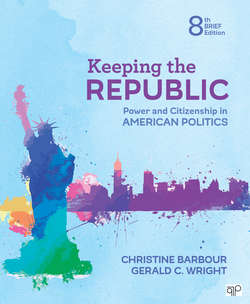Читать книгу Keeping the Republic - Christine Barbour - Страница 92
На сайте Литреса книга снята с продажи.
Federalists Versus Anti-Federalists
ОглавлениеSo strongly partisan were the supporters and opponents of the Constitution that, if the battle were taking place today, Twitter feeds would be on fire and we would probably find the two sides sniping at each other on cable TV programs like The Sean Hannity Show and Hardball With Chris Matthews, and Samantha Bee would be busy mocking both groups. It was a fierce, lively battle to control the narrative of what the new republic would be like, but instead of producing viral videos with the lifespan of a fruit fly and high television ratings, it yielded some of the finest writings for and against the American system. Those in favor of ratification called themselves Federalists. The Federalists, like Delegate A in our earlier hypothetical constitution-building scenario, were mostly men with a considerable economic stake in the new nation. Having fared poorly under the Articles, they were certain that if America were to grow as an economic and world power, it needed to be the kind of country people with property would want to invest in. Security and order were key values, as was popular control. The Federalists thought people like themselves should be in charge of the government, although some of them did not object to an expanded suffrage if government had enough built-in protections. Mostly they were convinced that a good government could be designed if the underlying principles of human behavior were known. If people were ambitious and tended toward corruption, then government should make use of those characteristics to produce good outcomes.
The Anti-Federalists told a different story. They rejected the notion that ambition and corruption were inevitable parts of human nature. If government could be kept small and local, the stakes not too large and tempting, and popular scrutiny truly vigilant, then Americans could live happy and contented lives without getting involved in the seamier side of politics. America did not need sprawling urban centers of commerce and trade; nor did it need to be a world power. If it did not stray from its rural roots and values, it could permanently avoid the creeping corruption that the Anti-Federalists believed threatened the American polity. The reason the Anti-Federalists found the Articles of Confederation more attractive than the Constitution was that the Articles did not call for a strong central government that, distant from the voters’ eyes, could become a hotbed of political intrigue. Instead, the Articles vested power in the state governments, which could be more easily watched and controlled.
Writing under various aliases as well as their own names, the Federalists and Anti-Federalists fired arguments back and forth in pamphlets and newspaper editorials aimed at persuading undecided Americans to come out for or against the Constitution. Because the channels of communication were limited, the competing ideas were concentrated into two streams. The Federalists were far more aggressive and organized in their “media blitz,” hitting New York newspapers with a series of eloquent editorials, known collectively as The Federalist Papers, published under the pen name Publius but really written by Alexander Hamilton, James Madison, and John Jay. These essays were bound and distributed in other states where the ratification struggle was close. The Federalist Papers is one of the main texts on early American politics today. In response, the Anti-Federalists published essays under names such as Cato, Brutus, and the Federal Farmer.23
The Federalist Papers a series of essays written in support of the Constitution to build support for its ratification
